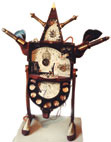Alexandru Nestor plays
with palpable things in order to create illusion. His works are the
result of conspicuous combinations of heterogeneous objects. In his way,
Nestor is a preposterous collector of curios. His studio looks like a
cabinet of a Renaissance prince with scientific propensities. Shells,
rocks and gems, bottles of every kind, old maps end books, coins,
herbarium, clockworks, feathers end stuffed birds are collectible items
which cover in piles the floor and every corner of the room. From this
heap of objects the artist selects the elements for his unorthodox works.
Nestor has a juvenile appetite for games: his works are puzzle-like
compositions.
Using cobbler’s old hoot patterns, thousand of little clock wheels,
bells, bulbs, switches and every conceivable outdated, discarded objects
Nestor re-creates a world, a world of his own. For Nestor is a dreamer
end a master of illusion as well. The tiny objects from which he combines his works arc not junks as those
used by the Danish artists Henry Heerup and William Freddie in mid
1930s. Instead they are leftovers from various old workshops. Skilled in
many fields Nestor is, in the meantime, cobbler, joiner, plumber,
blacksmith, watchmaker and jeweler for his assemblages. His works ore
mainly wooden boxes, cases, caskets and trunks of various size end shape.
Some of them are anthropomorphic figures sustained on wooden hoot
patterns. The hated heeds are actually lighted bulbs with their shades.
Thus the assemblage figures become functional also. Clocks are
incorporated in others. Some resemble scientific instruments with plenty
of dials and scales, often electrically activated. Still others are
mocking precious pieces of furniture. In every shelf or every drawer
there is a surprise: a shell, a butterfly, a stone, a leaf, a root, o
feather, a nickel, a stamp, a toy figure or a photograph.
|
As a genuine collector Nestor labeled all these exhibits, sometimes in Latin or German, using scientific terms. Nestor
has also in mind the pictorial side of his works. The brass drawers’
handles and hinges are glittering on the polished mahogany. Sometimes
dried leafs are pasted on the doors of his tiny sideboards. Their
natural shades rendered vividness to the whole. Thus the artist succeeds
to bridge the elusive gap between life and art. Other surfaces are
covered with stamps and scraps from old newspapers and commercials.
History and culture resound in these collage pictures. Nestor uses sometimes paint for his sophisticated works. Within his
subdued, refined palette, which frequently was related to his gold end
silvers of precious metals, he would put forth either matte or brilliant
examples of these colors, along with purple, pink and red. Humor plays a great part in Nestor’s art. The idea of combining such
heterogeneous items in order to obtain a case or an assemblage figure is
humorous in itself. Besides, titles are ironically chosen too: The
Flossy Chinese, The Tired Maid, The Sensible Triangle, Three-tongues
Warrior, and A Butterfly Infatuated with Armstrong. Recently Nestor was inspired by old German legends and Richard
Wagner’s operas. Consequently ho illustrated, in his original way The
Rhinegold. The juxtaposition of dials end scales are meant to reveal
King Niebelung’s coat of mail. The arched top of a sideboard
magnificently suggests Hagen’s befeathered helmet. Darker shades are
intended to stress the gloomy nature of this character. With wide cultural propensities Alexandru Nestor is able to portray a
mythic past and to destroy the cliché of contemporary life using its
own weapons.
Adrian
Silvan Ionescu
©World
Of Art magazine
|

